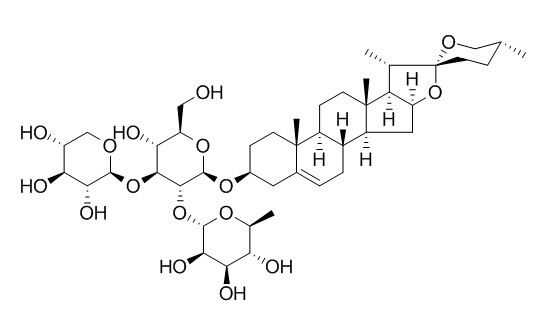Ophiopogonin D'
Ophiopogonin D' can activate SIRT1, it also noncompetitively inhibits UGT1A6 and UGT1A10.
Inquire / Order:
manager@chemfaces.com
Technical Inquiries:
service@chemfaces.com
Tel:
+86-27-84237783
Fax:
+86-27-84254680
Address:
1 Building, No. 83, CheCheng Rd., Wuhan Economic and Technological Development Zone, Wuhan, Hubei 430056, PRC
Providing storage is as stated on the product vial and the vial is kept tightly sealed, the product can be stored for up to
24 months(2-8C).
Wherever possible, you should prepare and use solutions on the same day. However, if you need to make up stock solutions in advance, we recommend that you store the solution as aliquots in tightly sealed vials at -20C. Generally, these will be useable for up to two weeks. Before use, and prior to opening the vial we recommend that you allow your product to equilibrate to room temperature for at least 1 hour.
Need more advice on solubility, usage and handling? Please email to: service@chemfaces.com
The packaging of the product may have turned upside down during transportation, resulting in the natural compounds adhering to the neck or cap of the vial. take the vial out of its packaging and gently shake to let the compounds fall to the bottom of the vial. for liquid products, centrifuge at 200-500 RPM to gather the liquid at the bottom of the vial. try to avoid loss or contamination during handling.
Asian J Beauty Cosmetol2020, 18(3): 265-272.
Evid Based Complement Alternat Med.2020, 2020:9416962.
Biomedicines.2022, 10(3):583.
Mol Biol Rep.2024, 51(1):117.
Int J Mol Sci.2023, 24(6):5769.
Biol Pharm Bull.2018, 41(11):1685-1693
Antioxidants (Basel).2021, 10(9):1487.
Biochemical Systematics and Ecology2018, 81
Molecules.2019, 24(4):E709
Curr Res Food Sci.2024, 9:100827.
Related and Featured Products
Evid Based Complement Alternat Med. 2014;2014:594354.
The Inhibition of the Components from Shengmai Injection towards UDP-Glucuronosyltransferase.[Pubmed:
25530784]
The mechanism of shengmai injection- (SMI-) related drug-drug interaction remains unclear. Evaluation of the inhibition potential of SMI's ingredients towards UDP-glucuronosyltransferases (UGTs) activity will provide a new insight to understand SMI-related drug-drug interaction.
METHODS AND RESULTS:
In vitro incubation system to model UGT reaction was used. Recombinant UGT isoforms-catalyzed 4-methylumbelliferone (4-MU) glucuronidation and UGT1A4-catalyzed trifluoperazine (TFP) glucuronidation reactions were employed to phenotype the inhibition profile of maidong's components towards the activity of UGT isoforms. Different inhibition potential of maidong's components towards various UGT isoforms was observed. Based on the inhibition kinetic investigation results, ophiopogonin D (OD) noncompetitively inhibited UGT1A6 and competitively inhibited UGT1A8, Ophiopogonin D' (OD') noncompetitively inhibited UGT1A6 and UGT1A10, and ruscorectal (RU) exhibited competitive inhibition towards UGT1A4. The inhibition kinetic parameters were calculated to be 20.6, 40.1, 5.3, 9.0, and 0.02 μM, respectively.
CONCLUSIONS:
In combination with our previous results obtained for the inhibition of UGT isoforms by ginsenosides and wuweizi components, the important SMI ingredients exhibiting strong inhibition towards UGT isoforms were highlighted. All the results obtained in the present study provide a new insight to understand SMI-related drug-drug interaction.
Anal Chem. 2015 May 19;87(10):5046-9.
Specific Turn-On Fluorescent Probe with Aggregation-Induced Emission Characteristics for SIRT1 Modulator Screening and Living-Cell Imaging.[Pubmed:
25903518]
SIRT1 is an important protein that catalyzes the nicotinamide adenine dinucleotide (NAD)(+)-dependent deacetylation reaction, which is regarded as a novel target to treat metabolic disorders and aging-related diseases. However, there is lack of appropriate approach for SIRT1 modulator screening and bioimaging of SIRT1 in living cells.
METHODS AND RESULTS:
We designed and synthesized a "turn-on" fluorescent probe by connecting a specifically recognized peptide to tetraphenylethene core. It exhibits excellent selectivity and sensitivity in homogeneous measurement of SIRT1 activity for screening both SIRT1 inhibitors and activators. 20(S)-ginsenoside Rg3 and Ophiopogonin D' were found to activate SIRT1. It was also successfully applied to monitor SIRT1 modulation in the cardiomyocytes as well as in the wild-type and SIRT1(-/-) mesenchymal stem cells.



